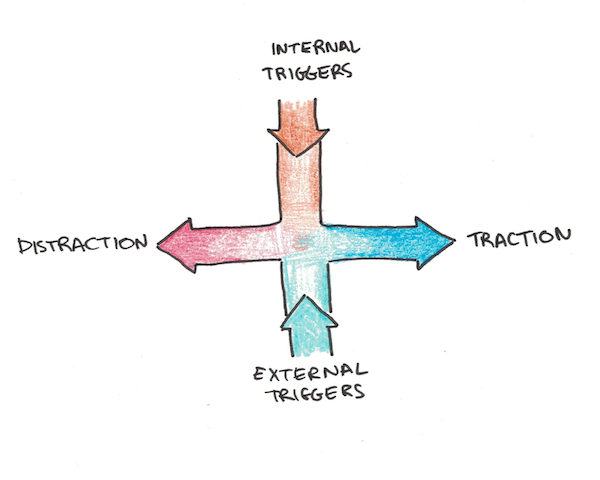I recently finished reading an advance copy of Nir Eyal’s new book, Indistractable. Even as someone who has written extensively about focus and productivity, the book was densely packed with useful advice.
The obvious comparison to Indistractable is Cal Newport’s, Deep Work and Digital Minimalism. Heck, the book even has the same yellow cover. (I guess yellow is the color of focus?)

I was pleasantly surprised, then, that Indistractable is a lot more than just rehashing what you’d already expect. In many ways, Eyal’s book is a good companion guide to Newport’s introducing different ideas and techniques. For a problem as big as distraction, two books are definitely better than one.
The 4-Part System for Being Indistractable
Eyal breaks down his system for becoming indistractable into four parts, neatly visualized as a crossroads of four intersecting factors:

The vertical axis explains why we often get distracted. External distractions are some of the problem. But, as Eyal explains, a lot of our distractions come from within. It may be easier to blame your smartphone for your distraction than to confront all the ways you’re distracting yourself to avoid boredom, frustration or the truth that you’re not doing what you need to in life.
The horizontal axis splits between distraction and “traction”. Distraction is what you’re trying to avoid. Traction is what you’re trying to accomplish.
This is also a useful distinction because once you overcome your distractions, what do you do then? Do you just fill your waking hours with more work? Do you stare blankly at the walls of your house, waiting for something to happen?
Any conversation about giving up distraction must be paired with a deep reflection of what kinds of activities you’d like to do instead.
What Sets This Book Apart
Is technology to blame for our distractedness? Or is technology just the symptom of our deeper issues with living the kind of lives we want?
I found Eyal’s take useful because, while I also enjoyed Deep Work and Digital Minimalism, I still use technology a lot. I use Twitter. I watch YouTube. I have email, an iPhone, text messages and group chats. I use these because they make my life easier and more enriching. While I have taken hiatuses from them, I always go back because I find them valuable.
Despite deciding, overall, that I want these services in my life, I also find that it’s tempting to overuse them. It’s easier to continually refresh Twitter, rather than go read a book. It’s easier to watch a Netflix show than to have a deep conversation with your spouse. It’s easier to play on your phone than to truly be present.
Eyal, like me, doesn’t demonize technology, but recognizes that we need to be in control of it and not the other way around.
On Raising Indistractable Children
Tucked away, at the end of the book, Eyal argues what is perhaps the most healthy and sane approach I’ve seen from parenting in awhile. He argues that you ought to treat your children like rational individuals and help them become indistractable themselves.
Instead, the approach I so often see from parents is that of the do-as-I-say-not-as-I-do parenting, where parents who are wrapped up in their own distractions nonetheless demand ascetic habits from their children.
I’ve faced this with parents who ask how they can get their children to use effective studying methods. I’m always surprised that the answer, “Assist them in making a study plan so they can accomplish their own goals,” rarely crosses their mind. As if children lack their own values and priorities, for which academic success is just one goal of many.
Eyal talks about working with his five-year old daughter to set limits on how much time she spent on the iPad. To his surprise, when he asked her how much she thought she should use it per day, the answer wasn’t unlimited but a modest two episodes of her favorite show.
Since ever-escalating controlling parenting seems to be the norm, it was refreshing that Eyal argues that we ought to treat our children like human beings.
Recommending Indistractable
Focus is an important topic. No one book or resource can give you all of the ideas and tools that might be helpful. The question therefore, isn’t whether you should read this book or Cal Newport’s or my articles, but whether this guide offers new ideas and advice to take you further. Indistractable does.

 I'm a Wall Street Journal bestselling author, podcast host, computer programmer and an avid reader. Since 2006, I've published weekly essays on this website to help people like you learn and think better. My work has been featured in The New York Times, BBC, TEDx, Pocket, Business Insider and more. I don't promise I have all the answers, just a place to start.
I'm a Wall Street Journal bestselling author, podcast host, computer programmer and an avid reader. Since 2006, I've published weekly essays on this website to help people like you learn and think better. My work has been featured in The New York Times, BBC, TEDx, Pocket, Business Insider and more. I don't promise I have all the answers, just a place to start.